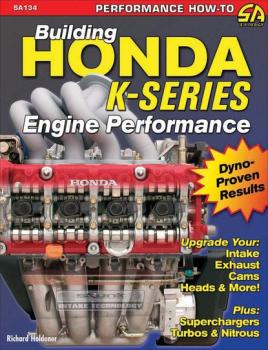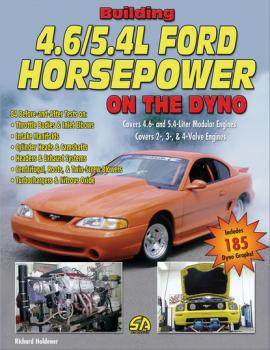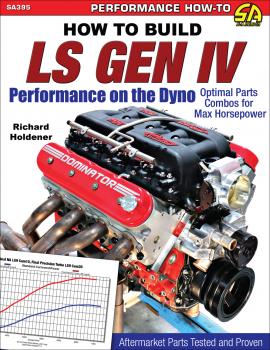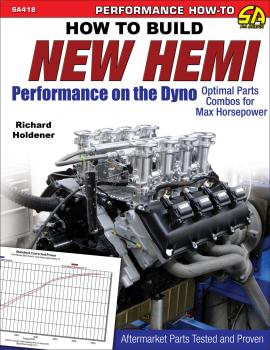Richard Holdener
Список книг автора Richard HoldenerBuilding Honda K-Series Engine Performance
The photos in this edition are black and white.<p>Honda and Acura practically invented sport-compact performance, and racers have proven that the popular B-series engines can make huge horsepower numbers both boosted and naturally aspirated – but times are changing. The all-new K-series engines are now found in all Honda and Acura performance models, and are also becoming the engine swap of choice. <p><In <i>Building Honda K-Series Engine Performance</i>, author Richard Holdener gives you a detailed description of the K-series engines, the various kinds of aftermarket performance parts available, and describes how these parts perform on the dyno. <p>Each chapter contains numerous color photos and back-to-back dyno tests run on a variety of different test motors including the K20A3, K20A2, K20Z3, K24AZ, and K24A4. You'll find chapters detailing upgrades to the intake, exhaust, cylinder heads, camshafts, and tuning, plus turbochargers, superchargers, and nitrous oxide. Don't spend your hard-earned cash figuring out what works and what doesn't – pick up <i>Building Honda K-Series Engine Performance</i> and know for sure.
Building 4.6/5.4L Ford Horsepower on the Dyno
The photos in this edition are black and white.<p>The 4.6- and 5.4-liter modular Ford engines are finally catching up with the legendary 5.0L in terms of aftermarket support and performance parts availability. Having a lot of parts to choose from is great for the enthusiast, but it can also make it harder to figure out what parts and modifications will work best. Building 4.6/5.4L Ford Horsepower on the Dyno takes the guesswork out of modification and parts selection by showing you the types of horsepower and torque gains expected by each modification. <p>Author Richard Holdener uses over 340 photos and 185 back-to-back dyno graphs to show you which parts increase horsepower and torque, and which parts don't deliver on their promises. Unlike sources that only give you peak numbers and gains, <i>Building 4.6/5.4L Ford Horsepower on the Dyno</i> includes complete before-and-after dyno graphs, so you can see where in the RPM range these parts make (or lose) the most horsepower and torque. Holdener covers upgrades for 2-, 3-, and 4-valve modular engines, with chapters on throttle bodies and inlet elbows, intake manifolds, cylinder heads, camshafts, nitrous oxide, supercharging, turbocharging, headers, exhaust systems, and complete engine buildups.
How to Build LS Gen IV Performance on the Dyno
The GM LS engine has redefined small-block V-8 performance. It's the standard powerplant in many GM cars and trucks and it has been installed in a variety of muscle cars, hot rods, and specialty cars to become the undisputed sales leader of crate engines. The aftermarket has fully embraced the GM Gen IV LS engine platform offering a massive range of heads, intakes, pistons, rods, crankshafts, exhaust, and other parts. <p>Seasoned journalist and respected author Richard Holdener reveals effective, popular, and powerful equipment packages for the Gen IV LS engine. With this information, you can select the parts to build a powerful and reliable engine by removing the research time and guesswork to buy a performance package of your own. In this book, performance packages for high-performance street, drag race, and other applications are covered. And then the assembled engine packages are dyno tested to verify that the parts produce the desired and targeted performance increases. This comprehensive build-up guide covers intakes, throttle bodies, manifolds, heads and camshafts, headers and exhaust, engine controls, superchargers and turbochargers, and nitrous oxide.<p>With so many parts available from a myriad of aftermarket companies, it's easy to become confused by the choices. This book shows you a solid selection process for assembling a powerful engine package, shows popular packages, and then demonstrates the dyno results of these packages. As such, this is an indispensible resource for anyone building GM LS Gen IV engine.
How to Build New Hemi Performance on the Dyno
Hemi. The word conjures up visions of racing and street domination. Widely regarded as one of the greatest American V-8s ever produced, Chrysler released its third-generation version of the engine in 2003 and installed it in a wide range of Chrysler cars and trucks. Through the years, the 5.7, 6.1, 6.2 Hellcat, and 6.4 Hemi engines have established an impressive high-performance reputation that builds on the proud heritage of the engine family. Most stock Hemi engines produce an impressive one horsepower per cubic inch, but they can make substantially more torque and horsepower for specific applications.<p>Fitted with the right high-performance parts, these powerful engines can produce far more horsepower and torque than stock. Selecting the ideal parts for the engine and application is essential. Veteran author and dyno testing expert Richard Holdener has done the research, gathered the data, and provided a detailed analysis of the results. Within the pages of this book, heads and camshafts, headers and exhaust, intakes, throttle bodies, manifolds, electronic engine controls, forced-air induction, and nitrous oxide are all tested. Using this comprehensive information and the dyno results, you can select the best performance parts for your engine and application. Each test provides a thorough description of the parts, test engine, and testing conditions, plus evaluation and insight into the results. Tests from budget to high-end engine builds are conducted to fit a wide spectrum of applications, so you can apply the testing data and results to your specific build project. Horsepower and torque graphs illustrate dyno test results for clear comparisons. In turn, it takes all the guesswork out of selecting parts, which saves you time and money.<p>Although the New Hemi produces excellent performance in stock form, it’s just the starting point. With the right parts, you can build the most potent street, street/strip, or full-race engine. Whether you’re building a mild street Hemi, a race engine, or something in between, this book is a valuable resource.



